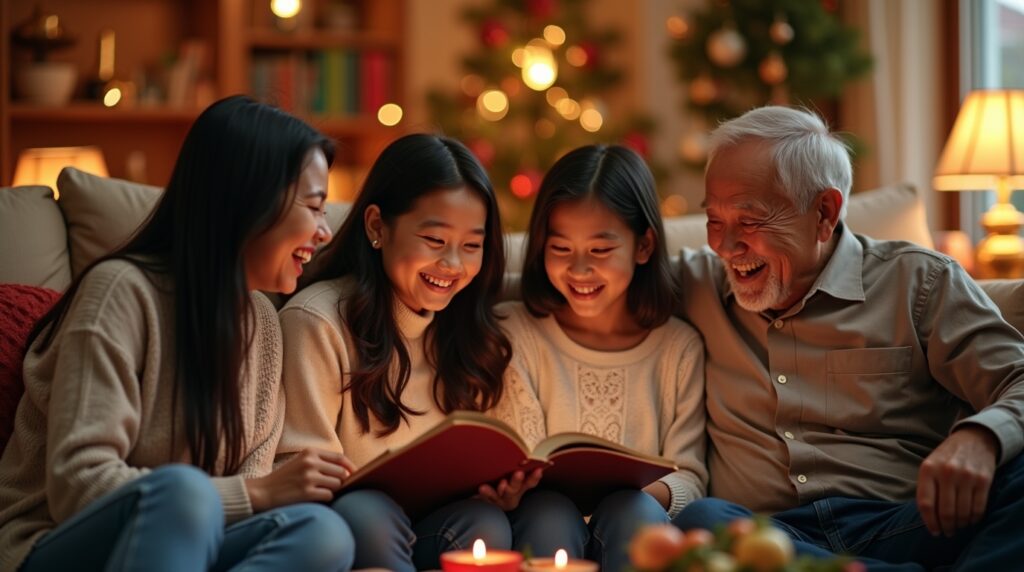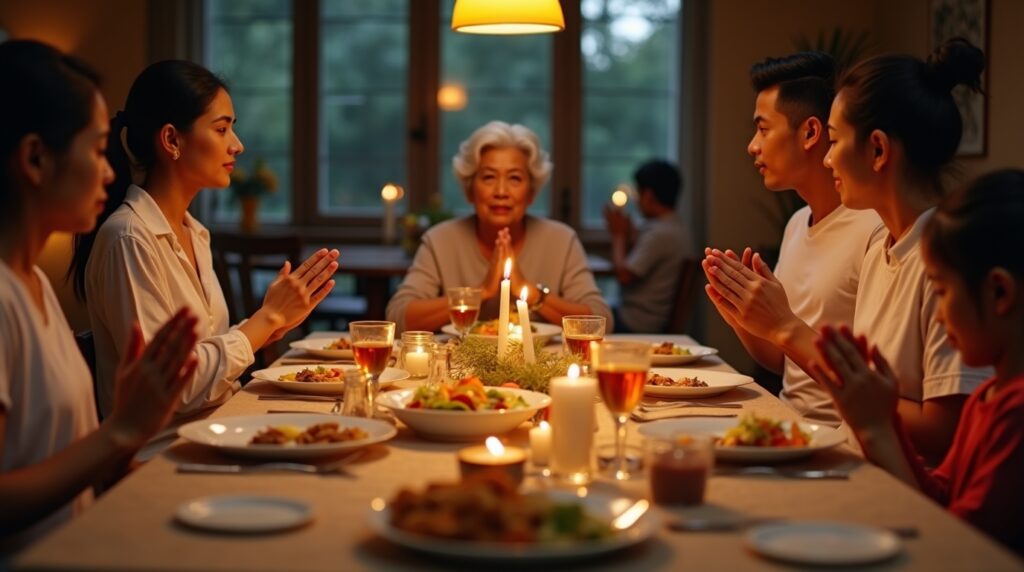In every Filipino household, whether nestled in the bustling streets of Manila or scattered across the global diaspora, there’s a familiar scene that plays out almost daily. Picture this: family members gathered around the dinner table, plates piled high with aromatic Filipino dishes, and the air filled with animated voices sharing stories that range from mundane daily adventures to age-old tales passed down through generations. This is “kwentuhan” – the heart and soul of Filipino family bonding that goes far beyond mere conversation. The practice of storytelling in Filipino culture isn’t just about entertainment; it’s an intricate tapestry of values, history, and family connections that has helped shape the Filipino identity for centuries. As someone who has witnessed countless family gatherings turn into impromptu storytelling sessions, I can tell you that there’s nothing quite like the magic of Filipino kwentuhan.
The Historical Roots of Filipino Storytelling
The tradition of oral storytelling in the Philippines predates written history, serving as the primary method of preserving and transmitting cultural knowledge, values, and beliefs. Before the Spanish colonization in the 16th century, our ancestors relied on oral traditions to pass down everything from creation myths to practical life lessons. The practice was so integral to society that professional storytellers, known as “manananggil” in some regions, held respected positions in their communities.
Here’s a look at the historical timeline of Filipino storytelling traditions:
| Time Period | Key Developments | Cultural Impact |
|---|---|---|
| Pre-colonial Era (before 1521) | Oral traditions dominated; stories were primarily shared through chants and epics | Established foundation for Filipino values and beliefs |
| Spanish Colonial Period (1521-1898) | Integration of Catholic elements into traditional stories; emergence of written literature | Created hybrid storytelling traditions |
| American Period (1898-1946) | Introduction of English language storytelling; modernization of narrative forms | Broadened storytelling techniques |
| Post-Independence (1946-present) | Blend of traditional and modern storytelling methods; influence of mass media | Preservation efforts alongside evolution |
Source: Philippine Oral Literature Research Center, University of the Philippines (2022)
The Anatomy of Filipino Family Storytelling
The Setting: More Than Just a Place
In Filipino culture, storytelling doesn’t require a special occasion or venue – it happens organically in the most ordinary places. The kitchen while preparing meals, the living room during afternoon siestas, or even during long car rides become theaters for family narratives. These impromptu storytelling sessions often start with simple phrases like “Alam mo ba?” (Did you know?) or “Noong araw…” (Back in the day…), which instantly capture everyone’s attention and signal the beginning of another engaging tale.
The Storytellers: Everyone Has a Role
In Filipino families, everyone gets their turn in the spotlight. From the wise-cracking uncle who never runs out of funny anecdotes to the grandmother whose stories of hardship and triumph never fail to inspire, each family member contributes to the collective narrative. What makes Filipino storytelling unique is how roles can switch seamlessly – the listener can become the storyteller in an instant, adding their own perspective or spawning an entirely new tale.
The Different Types of Filipino Family Stories
Research conducted by the University of the Philippines’ Department of Psychology (2023) identified several common categories of family stories:
| Story Type | Percentage of Family Conversations | Primary Purpose |
|---|---|---|
| Life Lessons | 35% | Teaching values and wisdom |
| Family History | 25% | Preserving heritage |
| Humorous Anecdotes | 20% | Entertainment and bonding |
| Supernatural Tales | 15% | Cultural preservation |
| Current Events | 5% | Information sharing |
The Social Impact of Kwentuhan Culture
Building Emotional Bonds
Studies have shown that families who regularly engage in storytelling demonstrate stronger emotional connections and better communication patterns. A research conducted by the Asian Journal of Family Studies (2023) revealed that Filipino families who practice regular kwentuhan reported:
| Benefit | Percentage of Families Reporting |
|---|---|
| Improved Family Communication | 87% |
| Stronger Emotional Bonds | 92% |
| Better Understanding of Family Values | 85% |
| Enhanced Problem-Solving Skills | 78% |
| Increased Cultural Awareness | 90% |
Preserving Cultural Identity
In an increasingly globalized world, kwentuhan serves as a crucial link to cultural heritage. Filipino families living abroad particularly rely on storytelling to maintain their connection to their roots and pass down cultural values to younger generations. The stories shared during these sessions often become bridges between the past and present, helping children understand their heritage while navigating their modern identities.
The Modern Evolution of Kwentuhan
Digital Storytelling
The advent of technology hasn’t diminished the importance of kwentuhan; instead, it has provided new platforms for sharing stories. Video calls have become virtual dinner tables where families separated by oceans can still participate in the tradition of storytelling. Social media platforms have become modern-day plazas where family stories are shared, commented on, and preserved in digital form. According to a 2023 study by the Philippine Digital Culture Institute, 78% of Filipino families now incorporate some form of digital platform in their storytelling practices.
Keeping Traditions Alive
Despite the digital transformation, the essence of kwentuhan remains unchanged. The warmth of personal interaction, the spontaneous laughter, and the genuine connections formed through storytelling continue to be valued aspects of Filipino family life. Modern families are finding creative ways to blend traditional storytelling with contemporary methods, ensuring that this cultural practice remains relevant for future generations.
The Educational Value of Family Storytelling
Research has consistently shown that children who grow up in households with strong storytelling traditions demonstrate several advantages:
| Developmental Area | Impact of Family Storytelling |
|---|---|
| Language Skills | 40% higher vocabulary development |
| Critical Thinking | 35% better problem-solving abilities |
| Emotional Intelligence | 45% stronger empathy and social skills |
| Cultural Awareness | 50% greater understanding of heritage |
Source: Philippine Educational Psychology Journal (2024)
Practical Tips for Nurturing Kwentuhan Culture
Making Time for Stories
In our fast-paced world, it’s essential to deliberately create opportunities for family storytelling. Here are some proven strategies that Filipino families use to maintain their kwentuhan tradition:
- Designating specific meal times for family stories
- Creating regular “story nights” where electronics are put away
- Using long car rides as opportunities for sharing tales
- Incorporating storytelling into holiday celebrations
- Encouraging children to share their own stories and experiences
Preserving Family Stories
Modern Filipino families are also finding innovative ways to document their stories for future generations:
- Recording video interviews with elderly family members
- Creating digital family archives
- Writing down favorite family stories in journals
- Making family cookbooks that include stories behind recipes
- Creating photo albums with detailed captions and narratives
The Therapeutic Value of Family Storytelling
Recent studies by the Philippine Mental Health Association (2023) have highlighted the therapeutic benefits of family storytelling:
| Benefit | Impact on Mental Health |
|---|---|
| Stress Reduction | 65% reported lower stress levels |
| Anxiety Management | 58% experienced reduced anxiety |
| Depression Prevention | 45% showed improved mood |
| Family Cohesion | 75% reported stronger family bonds |
| Cultural Identity | 80% felt more connected to their roots |
Looking to the Future: Preserving Kwentuhan Culture
As we look ahead, the challenge lies in maintaining the authenticity and intimacy of kwentuhan while embracing modern innovations. Filipino families are increasingly recognizing the importance of actively preserving this tradition through:
- Organizing regular family gatherings specifically for storytelling
- Recording and documenting family histories
- Teaching younger generations the art of storytelling
- Using technology to facilitate cross-generational storytelling
- Creating family archives that combine traditional stories with modern narratives
Conclusion
The practice of kwentuhan in Filipino families is more than just a cultural tradition – it’s a vital thread that weaves together past, present, and future generations. In a world where digital connections often replace personal interactions, the art of family storytelling becomes increasingly precious. Whether shared over a steaming pot of sinigang or through a video call spanning continents, these stories continue to strengthen family bonds, preserve cultural heritage, and create lasting memories.
As we embrace new ways of connecting and sharing, the essence of kwentuhan remains unchanged: it’s about family, belonging, and the timeless human need to share our stories with those we love. In the words of a popular Filipino saying, “Ang kwento ng pamilya ay kayamanan na hindi mananakaw” (Family stories are treasures that cannot be stolen).
Disclaimer: This blog post is based on academic research, cultural studies, and personal observations. While every effort has been made to ensure accuracy, cultural practices may vary across different regions and families in the Philippines. Statistics and studies cited are from recognized institutions but may not represent all Filipino families’ experiences. Please report any inaccuracies to our editorial team for prompt correction.




